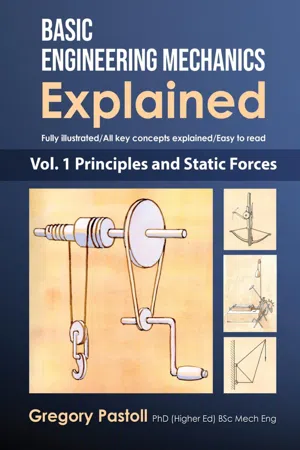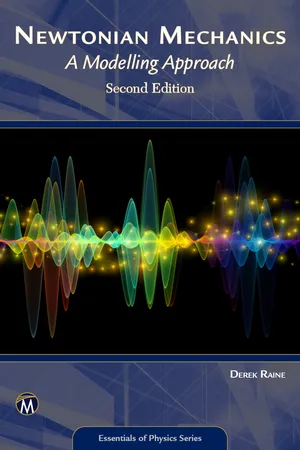Physics
Normal Force
The normal force is the force exerted by a surface to support the weight of an object resting on it. It acts perpendicular to the surface and prevents objects from passing through it. In equilibrium, the normal force is equal in magnitude and opposite in direction to the force of gravity acting on the object.
Written by Perlego with AI-assistance
8 Key excerpts on "Normal Force"
- No longer available |Learn more
- Robert A. Pelcovits, Joshua Farkas(Authors)
- 2023(Publication Date)
- Barrons Educational Services(Publisher)
mass, you’ll have to actually exercise.Various Forces Solving Newton’s law problems requires familiarity with the forces that you are likely to encounter. Some of the following may seem obvious now, but in the context of complicated problems, it’s easy to confuse things.1.GRAVITATIONAL FORCEFor now, we will be dealing with gravity near Earth’s surface.Magnitude: F = w = mgDirection: Down toward the center of Earth (not necessarily perpendicular to the surface that the object sits on, as in inclined plane problems).2.Normal Force—which we will denote FN .Magnitude: Determined by Newton’s second law.Direction: Always perpendicular (hence the term normal) to the surface the object is on and pointing away from the surface toward the object.Example: While a book of mass m is resting on a table, the table exerts a Normal Force on the book that points up and has a magnitude mg. It is Newton’s second law that tells us that the Normal Force must have magnitude mg because the acceleration is zero. (Newton’s third law tells us that the book exerts an equal and opposite Normal Force on the table.) If we exert an additional downward force of magnitude F on the book, then the Normal Force exerted on the book by the table will still point up but will have a larger magnitude of mg + F so that the net force on the book will remain zero.3.FRICTIONAL FORCEMagnitude: The magnitude of the frictional force can be determined from simple experiments. Slowly apply an increasingly strong horizontal force to an object on your desk. What do you observe? Up to a certain magnitude of force, the object doesn’t budge, but after a threshold force is reached, the object suddenly begins to accelerate. This can be explained in terms of Figure 3.1 - eBook - ePub
Biomechanics of Human Motion
Applications in the Martial Arts, Second Edition
- Emeric Arus, Ph.D.(Authors)
- 2017(Publication Date)
- CRC Press(Publisher)
If a skier slides down a hill, his weight acts perpendicular down to the inclined surface. The normal reaction force is also perpendicular to the surface but acts in the opposite direction. The normal reaction force in fact represents the classical Newton’s third law of motion that states that for every action there is an equal and opposite reaction. Therefore, when one object exerts a force on another, there will be an equal force exerted in the opposite direction by the second object on the first.Recall Newton’s first law of motion, which states that a body continues in a state of rest or uniform motion in a straight line unless it is acted upon by external forces.The reader can ask why this law does not apply when a body continues its motion on a rotary path. The reader should know that any change of direction even if that direction is always on the same path, such as a complete rotary circle motion, the object will accelerate.This acceleration is directed toward the center of the circle, with a magnitude equal to a = v 2 /r , where v is the velocity of the body or particle and r is the radius of the circle. The acceleration is called the centripetal or radial acceleration. The reason for the centripetal acceleration is the centripetal force acting on the body. This force is directed toward the center of the circle, and can be described from Newton’s second law: F = m ⋅ a = m ⋅ v 2 /r.We know about force which a body possesses that its effect is an interaction with another body. Humans experience interaction of different forces such as gravitational, physical, mechanical, electrical, and so on.The relationship between force and acceleration as given by Newton’s second law is valid to a motion if it is measured in a certain type of reference system called inertial frame of reference (IFR). An IFR is the one, in which Newton’s laws of motion are valid. The IFR is a zero accelerated frame of reference.Understanding velocity and force as vector quantities, the following will be described. When an object rotates around a fixed axis and moving with a constant speed, the object’s velocity vector is constant in magnitude but varies in direction. - eBook - ePub
Primary Science
Knowledge and Understanding
- Jenny Kennedy(Author)
- 2013(Publication Date)
- Routledge(Publisher)
- A force is needed to make an object start to move, to make it go faster, slow it down, stop it or make it change direction. In other words, a force is needed to change the movement of an object. If something is not moving, we can in almost every case conclude that the forces acting in each direction on the stationary object balance one another. A stationary object which has no force at all acting on it will not move. Without a force to slow down a moving object (i.e. ‘change its movement’), the object will carry on going straight at a steady speed. Applying a single force to it would make it go faster and faster – i.e. accelerate – or decelerate, or change direction, depending on the direction of that force.
- Forces always occur in pairs. If I exert a force on you, you will exert a force of the same size on me, although it will be in the opposite direction.
- If two compact, relatively heavy objects are dropped at the same time, they each pick up speed at the same rate, reaching the ground together – even if their weights differ.
- The Earth’s gravity pulls all objects toward the centre of the Earth – holding objects on its surface and pulling down falling objects. We call the force of gravity on an object its weight.
- Magnetic forces also act through space. A north pole attracts a south pole, but two similar poles (both south poles or both north poles) repel each other. A magnet will attract iron and other magnetic materials.
- When forces are applied to two surfaces in contact, to make them slide over one another, the force of friction comes into play. It acts against the direction of movement, slowing objects down, and can prevent movement altogether. Friction can be a hindrance in some cases, but a help in others. Friction forces are needed for rolling to occur.
- eBook - ePub
- Robert Lambourne(Author)
- 2019(Publication Date)
- CRC Press(Publisher)
N along these axes we see thatW =(1.16)(=)W x,W y(,m g sin θ , − m g cos θ)(Note the minus sign arising from the direction of the weight relative to the y -axis.) andIt follows that the total force on the brick isN =(1.17)(=)N x,N y(.0 , N)W + N =(1.18)(.m g sin θ , N − m g cos θ)Now, the motion of the brick is confined to the x-direction. Consequently, the brick is not accelerating in the y -direction, and, according to Newton’s first law, the resultant force component in the y -direction must therefore be zero. It follows from Equation 1.18 thati.e.N − m g cos θ = 0 ,N = m g cos θ .It then follows from Equation 1.17 that in this case,This result is a special case of the following general rule:N =(1.19)(.0 , m g cos θ)When a body exerts a contact force on a rigid surface, the surface exerts a normal reaction on the body. The normal reaction is directed at right angles to the surface and is equal in magnitude to the component of the contact force that is perpendicular to the surface.3.4 Friction, viscosity and air resistanceIn Section 2.2 you were introduced to the phenomenon of friction and the associated frictional forces that oppose the relative sliding motion of two solid surfaces in contact. In many respects friction plays a vital part in our lives; it allows us to park cars on hills, to tie knots in ropes, and even to walk. However, it also causes problems since it impedes the motion of objects, causes moving machine parts to wear, and dissipates potentially useful mechanical energy. In this subsection we take a more detailed look at friction, and then consider two other causes of dissipative forces, air resistance and viscosity. - eBook - ePub
- A. L. Stanford, J. M. Tanner(Authors)
- 2014(Publication Date)
- Academic Press(Publisher)
tension in the line is the magnitude of the force with which the line pulls on any object attached to either of its ends. Of course, a flexible line can only pull; one cannot push with a flexible line. Tension has the units of force. Although tension is a scalar quantity, it results in a vector force on any object to which a taut line is attached. The direction of that force is along the taut line, away from the attached object.An important aid in addressing word problems is a pictorial representation of the physical situation. A drawing of some kind is useful if the problem can be represented in a graphical way. Figure 3.2(a) is a drawing that represents the physical situation of the problem we are considering.Figure 3.2 Constructing a force diagram. (a ) The dashed circle assists in identifying all contact forces on the block. (b ) The isolated body is drawn with all the forces shown acting on the block. (c ) The block is represented in the force diagram as a particle at the origin of a rectangular coordinate system. All the forces acting on the block are drawn from the origin.Now we may consider what is known and what is to be determined in this problem. The mass of the block and a force acting on it are given. We are looking for the acceleration of the block. At this point we assume the direction in which we expect the block to accelerate. This is a guess, but it is one that does not require much intuition. Because the block is being pulled toward the right (in the positive x direction), we expect it to accelerate to the right. In Figure 3.2(a) we indicate the assumed direction of acceleration by the vector a . Now consider what relationship connects or relates the known force and mass to the unknown acceleration. Because the problem involves motion caused by force (that is, it is a dynamics problem), we should expect to use Newton’s second law. But the second law, ∑F = m a , requires that we use the net - eBook - ePub
Basic Engineering Mechanics Explained, Volume 1
Principles and Static Forces
- Gregory Pastoll, Gregory Pastoll(Authors)
- 2019(Publication Date)
- Gregory Pastoll(Publisher)
Factors like these collectively result in a resisting force that opposes the attempt to slide one surface over the other. It does not matter which combination of the three factors is actually responsible, because all of them could have an influence in resisting the sliding motion. What matters is that there is a single measurable effect, called the friction force.It is important for engineers to know how to estimate the value of the friction force in different circumstances. If you know the magnitude of the friction force that is likely to arise, you can make use of friction to assist a mechanical design to function, or make provision to minimise any undesirable friction that occurs.The factors that affect the magnitude of a frictional resistance There are only two factors that affect the magnitude of the force needed to slide one un-lubricated surface over another:• the amount of force pushing the two surfaces together, and• the coefficient of friction for the combination of the two materials.The force pushing two surfaces togetherThis is known as the normal reaction, N , because it is measured in a direction normal (perpendicular) to the two surfaces at their point of contact.It has been found by experiment that the greater this normal reaction force, N , the greater the friction force at the interface.Consider the following situations, and the free-body diagrams that apply to them: In each case the normal reaction, N , is determined by considering equilibrium in a direction perpendicular to the interface between the two objects in contact.Below are shown four situations in which a block is in contact with a plane. Below each diagram is a free-body diagram of the block, from which the equation for the value of N - eBook - ePub
Essentials of Physics Series
A Modelling Approach
- Derek Raine(Author)
- 2021(Publication Date)
- Mercury Learning and Information(Publisher)
Figure 2.1 were not to act through a common point, we should have a more complicated situation in which the block could tip over. We shall deal with this later: for the moment, all forces on an extended body are assumed to act through a common point. Alternatively, we can consider the body to be a point particle with no extension, so that all forces on it act through the same point by construction.Figure 2.2: Vertical forces on a block at rest on a horizontal plane. The reaction force R is equal and opposite to the weight WConsider now a block at rest on a flat plane as in Figure 2.2 . If we were to imagine ourselves in the role of the plane, for example, by holding the block in our hand, we would feel the block pushing down. We attribute this to the weight of the block. Let us call this force W .Thus, the block has a weight W , which is the force acting down on the plane. Experience shows that an unbalanced force causes an object to move. So we expect that the plane must act back on the block with a force equal and opposite to the weight of the block. In fact, if we imagine ourselves now in the role of the block, we feel this reaction as our weight. This is shown in Figure 2.2 , where each force is represented by an arrow that points in the direction of the force and has a length proportional to the magnitude of the force.The SI unit of force is the Newton (N), where 1 N = 1 kg m s−2 .Actually, in general, everyday experience alone does not always show that an unbalanced force causes an object to move. In one of the earliest systematic considerations of the issue, Aristotle pointed out that a man cannot move a ship.1 - eBook - ePub
- Hiqmet Kamberaj(Author)
- 2021(Publication Date)
- De Gruyter(Publisher)
Newton was able to answer the question of what force causes the planets to orbit around the Sun, and related questions by stating that forces are what cause any change in the velocity of an object. Thus, no force is required for the motion with a constant velocity of an object to be maintained. For example, the Moon’s velocity is not constant because it moves in a nearly circular orbit around the Earth because of the force exerted on the Moon by the Earth. Therefore, since the velocity of objects changes whenever a force is applied to them, then the forces make the objects accelerate. Here, we are concerned with the relationship between the force exerted on an object and the acceleration of that object.Equilibrium
In the case when more than one force acts upon an object simultaneously, if the net force acting on it is different from zero, then the object accelerates. By definition, the net (or resultant) force acting on an object is given by the vector sum of all vectors of the forces acting on the object:(5.1)F R=∑ iF iwhereF Ris the net force as the over all force, the resultant force, or the unbalanced force, and the sum runs overall forcesF iacting upon the object. If the resultant force,F R, exerted on an object is zero, then its acceleration is zero, and hence the velocity of that object remains unchanged. In other words, if, then the object either remains at the state of rest or continues moving with the same velocity. If an object moves with constant velocity or it is at rest (that is, its velocity is zero), the object is said to be in equilibrium.F R= 0When a coiled spring is pulled, as in Fig. 5.1 , the spring stretches and hence changes its state of rest. That is the case of contact forces.Figure 5.1 Example of applied contact force.To overcome the conceptual problem of non-contact forces, Michael Faraday (1791–1867) introduced the concept of a field. Based on this concept, if any object is placed near another object, then the objects interact with each other through the gravitational field. In this case, we say that a gravitational field is created by each object at the position of the other object. All objects create a gravitational field in the space around themselves. Field forces are those types of forces, which do not have physical contact between two objects, but they are acting through empty space. An example of the field force is the gravitational attraction force between two objects, illustrated in Fig. 5.2
Index pages curate the most relevant extracts from our library of academic textbooks. They’ve been created using an in-house natural language model (NLM), each adding context and meaning to key research topics.
Explore more topic indexes
Explore more topic indexes
1 of 6
Explore more topic indexes
1 of 4







